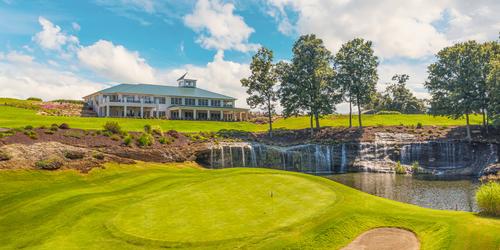
Omni Tucson National boasts 36 golf holes and rich golf history
By Kiel Christianson
Tucson, Arizona, is a long-time PGA Tour and Champions Tour stop. The Tucson Open was played (under various monikers) from 1945 to 2006. From 2015 onward, the Cologuard Classic (again, under multiple names) has been played against the backdrop of the lovely Santa Catalina Mountains. For around 35 years, the venue for these prestigious events was the Tucson National Golf Club, renamed in 1997 as Omni Tucson National Golf Resort and Spa. Golf history runs deep here.
In 2006, Tom Lehman and his golf course design firm were brought into Omni Tucson National to revamp the 27 Bruce Devlin and Robert von Hagge designed-holes and create another 9, expanding the playing options at the Omni to two 18-hole courses. And you'd be hard-pressed to find any golf resort in the Southwest that has two courses with more divergent feels and looks.
The Catalina Course is the more traditional design, with wider fairways, plenty of trees, and nary a cactus in sight. The most radical feature of the Catalina is its 5 par-5s, making for a par of 73. The Sonoran Course, on the other hand, is shorter - at par 70 - narrower, and replete with dry washes and all manner of prickly plants. This variety sets Omni Tucson National apart from most other golf resorts in the Southwest, where "multiple courses" means "multiple desert-style courses."
Given the dramatically different vibes of the two courses, I asked Omni Tucson National Resort's Direct of Golf, Brent Newcomb, which one is more popular with guests and visitors. "Well," he replied thoughtfully, "if they're interested in 35-plus years of PGA Tour history, then the Catalina. If they're from the North or Midwest, and they want to play 'desert golf,' then the Sonoran."
What sort of player tends to play well on one versus the other, I asked. "The Sonoran is a desert-style course," explained Newcomb. "There's not a premium on distance - more on accuracy. It's not 'target golf,' exactly, though, but there are elevation changes and waste areas. On the Catalina, there are five par-5s, so there are good scoring opportunities for longer hitters."
Playing the Catalina and Sonoran Courses at Omni Tucson National
I had the good fortune to play both the Catalina and Sonoran Courses during my visit, along with 13 other avid golfers who were in my group. Every one of us commented on the vastly different natures of the two layouts. From the back tees, the Catalina stretches to a tour-worthy 7,262 yards. The next-furthest back tees are 6,610, which then jump rather abruptly down to 5,717. Wisely, both courses offer both longer and shorter sets of combo tees. Most first-timers on the Catalina will find the "Medium Combo" (6,145) a comfortable compromise.
The Sonoran maxes out at 6,529 yards, but given the numerous blind landing areas and fair amount of local knowledge you need to plot your way around the course, the starter recommended the 5,995-yard white tees to me (a 10-handicap). Despite Newcomb's claim that the Sonoran isn't "target golf," I found it quite targety indeed. A couple of my group members reported feeling awkward throughout the round, as did I, due to both the yardages and the placement of hazards. One colleague drove his ball over the green on the downhill 304-yard 1st hole, for example, and there's no coming back from the drop-off behind that green. So longer hitters need to take club selection into account on nearly every hole, if the starters' advice is followed.
Back to the Catalina, the first few holes ease you into the round. From the opening hole - where bunkering, water, and a slight dogleg right conspire to constrict the fairway - you realize that here, too, choices will have to be made off the tee. Lehman does a nice job of placing bunkers and pinching fairways at multiple points, ensuring that players of all skill levels will need to pay attention, and none will be able to just blast their ball over them without considering what else lies beyond.
A fine example of this strategic plan is the par-4 9th, which plays between 436 yards from the tips to 300 yards from the forward tees (where some of the combo tees play). Water juts in from the right edge of the fairway, making a narrow landing area for a driver from the back tees or for a hybrid from the more forward tees. Alternatively, just a 200-yard carry will clear the water from the more forward tees. A long drive, however, makes for a delicate flip wedge over the yawning bunker with a 10-foot face that fronts the elevated green, and, if not placed correctly, may have some tree trouble.
The back nine of the Catalina features several shorter par-4s (depending on your tees), along with three of the five par-5s. So there's great variety and new challenges on nearly every hole. The 443-yard 18th was long-known as one of the toughest closing holes on the PGA Tour, with more water testing both distance and directional control off the tee.
The Sonoran looks, feels, and plays completely different from the Catalina from tee to green. Consider, for example, that I three-putted a grand total of one time on the Catalina, but three-putted 6 times on just the front side of the Sonoran. (I stopped counting after that.) I hit every single par-3 on the Sonoran in regulation but didn't par any of them. Whereas the Catalina greens are generally large, gently cantilevered, and quick, the Sonoran greens are variable in size, dramatically contoured, and, given the contouring, seem much faster.
The Sonoran's fairways also felt firmer, so shots really ran, especially with some of the elevation off the tees. This is great for gaining distance, but not so great if you don't know where, exactly, you're going. The carts all have GPS, fortunately, but sometimes yardages don't tell quite the whole story. Holes 4, 8, and 16, for example, all have cross-hazards of waste areas. On the downhill-then-uphill par-4 16th, for example, my best drive of the day ran down into the center of a gravelly waste area, from which I had to shoot back uphill toward a completely blind green.
The signature hole of the Sonoran is the daunting par-5 15th. From the very tips, it only plays 515 yards, but it is 100% uphill. On the day we played, it (along with all but two holes, somehow) played straight into the wind as well, so it felt more like 715 yards. In addition to the elevation, the fairway is littered with bunkers and OB runs along both sides, so a bogey here feels like a hard-earned par.
Unlike the Catalina, the Sonoran has almost no parallel holes, so wayward tee shots will likely end up in the desert or in the yard of one of the many homes lining most of the fairways. If I were to play the Sonoran again, I would play from a slightly longer set of tees ("long combo") and would also pull driver less often, choosing instead to keep the ball in play. And, I hope, I would learn how to putt those greens.
The verdict: Omni Tucson National
Omni Tucson National is steeped in golf history. It is a must-visit for northern golfers looking to escape winter's cold. During peak season - basically spring and fall, before the hot desert summer and then, later, the winter monsoons - rack rate is $220, including cart, range balls and water, with a 20% discount for resort guests. March and April are really the height of peak season. In the summer, that rate drops all the way down to $80 ($60 for guests), and Brent Newcomb notes that the summers in Tucson, while still hot, are cooler than Phoenix. (I've played summer golf in the desert, and it can be done if you plan accordingly.)
Visitors really should avail themselves of the vastly different experiences that the Catalina and Sonoran offer. Average golfers have a chance to score well first time out on the Catalina - it may be a Tour stop, but it's also a classic resort course, where, aside from ponds on about seven holes, recovery from wayward shots is possible.
First-timers on the Sonoran, however, should probably temper expectations for low scores. Local knowledge is critical here for club selection, tee selection, and line selection, so the layout doesn't really lend itself to typical "resort" play. The uninitiated are encouraged to bring both extra balls and extra patience, along with the requisite extra water needed on all the courses in the golf-rich Tucson area.
Revised: 04/26/2024 - Article Viewed 9,242 Times
- View Course Profile
About: Kiel Christianson
![]() I’ve been a travel and golf writer for online and print publications for 25 years, including over 10 years with The Golf Channel. My blog on The Golf Channel websites began in 2003, making it one of the first in the golf world. Other publications include poetry, food and travel features, and research articles in the broad area of cognitive science.
I’ve been a travel and golf writer for online and print publications for 25 years, including over 10 years with The Golf Channel. My blog on The Golf Channel websites began in 2003, making it one of the first in the golf world. Other publications include poetry, food and travel features, and research articles in the broad area of cognitive science.
Contact Kiel Christianson:
Midwestern Golf - Publisher
217-714-4561
















